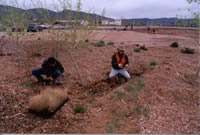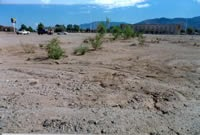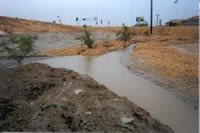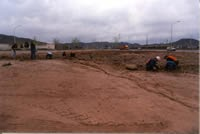Juan Tabo Erosion Control Project

in 1999, Ciudad SWCD initiated, designed, and constructed the Juan Tabo Project in coordination with the NM Recycling Coalition, the NM Environment Department, the City of Albuquerque, and the NM Department ofTransportation. The demonstration site, on westbound I-40 at the Juan Tabo interchange, shows ways to turn a liability - road runoff - into an asset used for highway beautification and resource conservation, resulting in reduced highway maintenance expenses.

Before, every rain storm washed soil and debris down the bare slopes bordering the roadway and into the storm drains and traffic lanes of Interstate 40. Ciudad graded the site to capture this runoff and detain it in long, narrow ponding areas, called swales. The collected water slowly soaks into these swales, where microorganisms help filter out pollutants and the soil gradually releases it to native landscape trees and shrubs. The entire site is protected by an organic mulch, which reduces water lass due to evaporation, fosters the plants' growth, eliminates air pollution from blowing dust, and stops sediment and trash from getting into the city storm sewers.

The District and its partners have worked with the State Department of Transportation to write new standards and specifications for roadsides, based on the positive impacts of this demonstration project. Replication of these simple conservation practices throughout the metropolitan area will result in reduced highway and drainage maintenance costs to taxpayers, less pollution entering our waterways, and a healthier watershed.

Changes made to the roadway since the project was installed had eliminated flow-on from the east, reducing water available to the site. However, numerous volunteer tress were observed within the still-functional swales and detention basins at the site. Click here to view photos from the visit.
